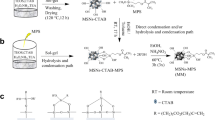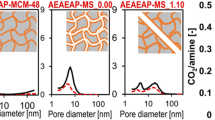Abstract
In the current study, a core-shell structured material of MCM-48-type mesoporous silica nanoparticles (MSNs) and cross-linked poly(N-isopropylacrylamide) homopolymer and its copolymer with methacrylic acid was synthesized. The polymer was preferentially grafted on the outer surface of silane linker-functionalized MSNs based on free radical polymerization. The successful chemical grafting of the polymer on the silica surface was confirmed by FTIR, NMR, TG, and elemental analyses. The polymer contents of the hybrid particles vary from 18 to 40 % as determined by thermogravimetric and elemental analyses. The polymer content was tailored by varying different reaction parameters including monomer concentration, linker content/type, and reaction time. Well-defined uniform core-shell structured spherical particles with an average particle size of 367 ± 25 nm and shell thickness of 29 ± 8 nm were observed in TEM analysis. According to XRD and nitrogen physisorption studies, the ordered mesopore structure of the core MCM-48-type MSNs was maintained after an extended polymer grafting process and surface coverage with a high content of polymer. No significant pore blockage was observed in porosimetry analysis. More than 75% of specific surface area, 68% of total pore volume, and the mean mesopore diameter were retained after successful grating of polymer on the outer silica surface. The pore volume thus can provide enough space to encapsulate high contents of cargo molecules for applications. The narrow pore width distribution of the main mesopores of silica determined by PALS analysis corresponds to the N2 sorption analysis and further confirms the uniformity of the mesopores.








Similar content being viewed by others
References
Wang Y, Zhao Q, Han N et al (2015) Mesoporous silica nanoparticles in drug delivery and biomedical applications. Nanomedicine Nanotechnology, Biol Med 11:313–327. https://doi.org/10.1016/j.nano.2014.09.014
Moraes J, Ohno K, Maschmeyer T, Perrier S (2013) Synthesis of silica–polymer core–shell nanoparticles by reversible addition–fragmentation chain transfer polymerization. Chem Commun 49:9077. https://doi.org/10.1039/c3cc45319g
Zhao XJ, Gao ZF, Jiang ZY (2015) A Study of HCl Gas Adsorption/Desorption Properties of PNIPAM Brushes. Macromol Theory Simulations 24:460–467. https://doi.org/10.1002/mats.201500027
Cao M, Shen Y, Yan Z et al (2021) Extraction-like removal of organic dyes from polluted water by the graphene oxide/PNIPAM composite system. Chem Eng J 405:126647. https://doi.org/10.1016/j.cej.2020.126647
Yadavalli T, Ramasamy S, Chandrasekaran G et al (2015) Dual responsive PNIPAM–chitosan targeted magnetic nanopolymers for targeted drug delivery. J Magn Magn Mater 380:315–320. https://doi.org/10.1016/j.jmmm.2014.09.035
Gupta P, Vermani K, Garg S (2002) Hydrogels: from controlled release to pH-responsive drug delivery. Drug Discov Today 7:569–579. https://doi.org/10.1016/S1359-6446(02)02255-9
Zheng Y, Wang L, Lu L et al (2017) pH and Thermal Dual-Responsive Nanoparticles for Controlled Drug Delivery with High Loading Content. ACS Omega 2:3399–3405. https://doi.org/10.1021/acsomega.7b00367
Li J, Wang L, Benicewicz BC (2013) Synthesis of Janus Nanoparticles via a Combination of the Reversible Click Reaction and “Grafting to” Strategies. Langmuir 29:11547–11553. https://doi.org/10.1021/la401990d
Tang F, Li L, Chen D (2012) Mesoporous Silica Nanoparticles: Synthesis, Biocompatibility and Drug Delivery. Adv Mater 24:1504–1534. https://doi.org/10.1002/adma.201104763
He Q, Shi J (2011) Mesoporous silica nanoparticle based nano drug delivery systems: synthesis, controlled drug release and delivery, pharmacokinetics and biocompatibility. J Mater Chem 21:5845. https://doi.org/10.1039/c0jm03851b
Guillet-Nicolas R, Popat A, Bridot J-L et al (2013) pH-Responsive Nutraceutical-Mesoporous Silica Nanoconjugates with Enhanced Colloidal Stability. Angew Chemie Int Ed 52:2318–2322. https://doi.org/10.1002/anie.201208840
He J, Shen Y, Evans DG (2008) A nanocomposite structure based on modified MCM-48 and polystyrene. Microporous Mesoporous Mater 109:73–83. https://doi.org/10.1016/j.micromeso.2007.04.051
Kalbasi RJ, Mosaddegh N (2011) Synthesis and characterization of poly(4 vinylpyridine) /MCM-48 catalyst for one-pot synthesis of substituted 4H-chromenes. Catal Commun 12:1231–1237. https://doi.org/10.1016/j.catcom.2011.04.004
Meléndez-Ortiz HI, Puente-Urbina B, Ibarra-Vallejo E et al (2018) Polyacrylamide-coated MCM-48 mesoporous silica spheres: synthesis, characterization and drug delivery study. J Porous Mater 25:649–656. https://doi.org/10.1007/s10934-017-0477-z
Yismaw S, Kohns R, Schneider D et al (2019) Particle size control of monodispersed spherical nanoparticles with MCM-48-type mesostructure via novel rapid synthesis procedure. J Nanoparticle Res 21:258. https://doi.org/10.1007/s11051-019-4699-7
Yismaw S, Ebbinghaus SG, Wenzel M et al (2020) Selective functionalization of the outer surface of MCM-48-type mesoporous silica nanoparticles at room temperature. J Nanoparticle Res 22:279. https://doi.org/10.1007/s11051-020-05006-2
Varga I, Gilányi T, Mészáros R et al (2001) Effect of Cross-Link Density on the Internal Structure of Poly( N -isopropylacrylamide) Microgels. J Phys Chem B 105:9071–9076. https://doi.org/10.1021/jp004600w
Datta P, Genzer J (2016) “Grafting through” polymerization involving surface-bound monomers. J Polym Sci Part A Polym Chem 54:263–274. https://doi.org/10.1002/pola.27907
Peng W, Zhang Z, Rong M, Zhang M (2019) Core-Shell Structure Design of Hollow Mesoporous Silica Nanospheres Based on Thermo-Sensitive PNIPAM and pH-Responsive Catechol-Fe3+ Complex. Polymers (Basel) 11:1832. https://doi.org/10.3390/polym11111832
Alli A, Hazer B (2011) Synthesis and Characterization of Poly(N-Isopropyl Acryl Amide)-g-Poly(Linoleic Acid)/Poly(Linolenic Acid) Graft Copolymers. J Am Oil Chem Soc 88:255–263. https://doi.org/10.1007/s11746-010-1663-1
Shukla A, Hoffmann L, Manuel AA, Peter M (1997) Melt 4.0 a Program for Positron Lifetime Analysis. Mater Sci Forum 255–257:233–237. https://doi.org/10.4028/www.scientific.net/MSF.255-257.233
Ciesielski K, Dawidowicz AL, Goworek T et al (1998) Positronium lifetimes in porous Vycor glass. Chem Phys Lett 289:41–45. https://doi.org/10.1016/S0009-2614(98)00416-3
Zaleski R, Wawryszczuk J, Goworek T (2007) Pick-off models in the studies of mesoporous silica MCM-41. Comparison of various methods of the PAL spectra analysis. Radiat Phys Chem 76:243–247. https://doi.org/10.1016/j.radphyschem.2006.03.044
Nagappan S, Park SS, Kim BK et al (2018) Synthesis and functionalisation of mesoporous materials for transparent coatings and organic dye adsorption. New J Chem 42:10254–10262. https://doi.org/10.1039/C8NJ00591E
Doadrio JC, Sousa EMB, Izquierdo-Barba I et al (2006) Functionalization of mesoporous materials with long alkyl chains as a strategy for controlling drug delivery pattern. J Mater Chem 16:462–466. https://doi.org/10.1039/B510101H
Jadhav SA, Brunella V, Miletto I et al (2016) Synthesis of poly(N -isopropylacrylamide) by distillation precipitation polymerization and quantitative grafting on mesoporous silica. J Appl Polym Sci 133. https://doi.org/10.1002/app.44181
Khan MS, Khan GT, Khan A, Sultana S (2013) Preparation and Characterization of Novel Temperature and pH Sensitive (NIPAM-co-MAA) Polymer Microgels and Their Volume Phase Change with Various Salts. Polym Korea 37:794–801. https://doi.org/10.7317/pk.2013.37.6.794
Gao X, Cao Y, Song X et al (2013) pH- and thermo-responsive poly(N-isopropylacrylamide-co-acrylic acid derivative) copolymers and hydrogels with LCST dependent on pH and alkyl side groups. J Mater Chem B 1:5578. https://doi.org/10.1039/c3tb20901f
Qian W, Wang H, Chen J, Kong Y (2015) Spherical V-Fe-MCM-48: The Synthesis, Characterization and Hydrothermal Stability. Materials (Basel) 8:1752–1765. https://doi.org/10.3390/ma8041752
Qu Y, Feng L, Tong C et al (2013) Poly(p-phenylenevinylene) functionalized fluorescent mesoporous silica nanoparticles for drug release and cell imaging. Microporous Mesoporous Mater 182:155–164. https://doi.org/10.1016/j.micromeso.2013.08.045
Colilla M, Martínez-Carmona M, Sánchez-Salcedo S et al (2014) A novel zwitterionic bioceramic with dual antibacterial capability. J Mater Chem B 2:5639–5651. https://doi.org/10.1039/C4TB00690A
Kitahara Y, Okuyama K, Ozawa K et al (2012) Thermal decomposition of acrylamide from polyacrylamide. J Therm Anal Calorim 110:423–429. https://doi.org/10.1007/s10973-012-2544-7
Nagase K, Kobayashi J, Kikuchi A et al (2008) Effects of Graft Densities and Chain Lengths on Separation of Bioactive Compounds by Nanolayered Thermoresponsive Polymer Brush Surfaces. Langmuir 24:511–517. https://doi.org/10.1021/la701839s
Humphreys BA, Prescott SW, Murdoch TJ et al (2019) Influence of molecular weight on PNIPAM brush modified colloidal silica particles. Soft Matter 15:55–64. https://doi.org/10.1039/C8SM01824C
Sing KSW, Everett DH, Haul RAW, Moscou L, Pierotti RA, Rouquerol J, Siemieniewska T (1985) Reporting physisorption data for gas/solid systems with special reference to the determination of surface area and porosity. Pure Appl Chem 57:603–619. https://doi.org/10.1515/iupac.57.0007
Kullmann J, Enke D, Thraenert S et al (2010) Characterization of nanoporous monoliths using nitrogen adsorption and positronium annihilation lifetime spectroscopy. Colloids Surfaces A Physicochem Eng Asp 357:17–20. https://doi.org/10.1016/j.colsurfa.2009.09.030
Gidley DW, Peng H-G, Vallery RS (2006) Positron annihilation as a method to characterize porous materials. Annu Rev Mater Res 36:49–79. https://doi.org/10.1146/annurev.matsci.36.111904.135144
Thornton AW, Jelfs KE, Konstas K et al (2016) Porosity in metal-organic framework glasses. Chem Commun 52:3750. https://doi.org/10.1039/c5cc10072k
Tanis-Kanbur MB, Peinador RI, Calvo JI et al (2021) Porosimetric membrane characterization techniques: A review. J Memb Sci 619:118750. https://doi.org/10.1016/j.memsci.2020.118750
Schneider D, Attallah AG, Wassersleben S et al (2020) Advanced textural characterization of biogenic silica by nitrogen physisorption, positron annihilation lifetime spectroscopy and hyperpolarized 129Xe NMR spectroscopy. Microporous Mesoporous Mater 307:110515. https://doi.org/10.1016/j.micromeso.2020.110515
Zaleski R, Błażewicz A, Kierys A (2013) Ortho-positronium migration in mesopores of MCM-41, MSF and SBA-3. Nukleonika 58:235–240 https://www.researchgate.net/publication/280640481
Zaleski R, Kierys A, Dziadosz M et al (2012) Positron annihilation and N2 adsorption for nanopore determination in silica-polymer composites. RSC Adv 2:3729. https://doi.org/10.1039/c2ra20147j
Jadhav SA, Nisticò R, Magnacca G, Scalarone D (2018) Packed hybrid silica nanoparticles as sorbents with thermo-switchable surface chemistry and pore size for fast extraction of environmental pollutants. RSC Adv 8:1246–1254. https://doi.org/10.1039/C7RA11869D
Funding
This research work was financially supported by the Institute of Chemical Technology, Faculty of Chemistry and Mineralogy, Universität Leipzig, and the German Academic Exchange Service (DAAD).
Author information
Authors and Affiliations
Corresponding authors
Ethics declarations
Conflict of interest
The authors declare no competing interests.
Additional information
Publisher’s note
Springer Nature remains neutral with regard to jurisdictional claims in published maps and institutional affiliations.
Rights and permissions
Springer Nature or its licensor (e.g. a society or other partner) holds exclusive rights to this article under a publishing agreement with the author(s) or other rightsholder(s); author self-archiving of the accepted manuscript version of this article is solely governed by the terms of such publishing agreement and applicable law.
About this article
Cite this article
Yismaw, S., Wenzel, M., Attallah, A.G. et al. Core-shell structured MCM-48-type silica-polymer hybrid material synthesis and characterization. J Nanopart Res 25, 21 (2023). https://doi.org/10.1007/s11051-022-05666-2
Received:
Accepted:
Published:
DOI: https://doi.org/10.1007/s11051-022-05666-2




